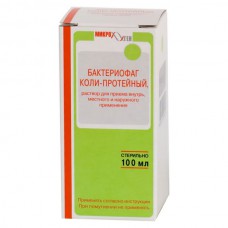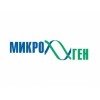Expiration date: 08/2026
Description
The drug causes specific lysis of the bacteria P. vulgaris, P. mirabilis, E. coli.
Release form
Solution for oral, topical and external use in vials of 20 or 100 ml. 8 bottles of 20 ml or 1 bottle of 100 ml with instructions for use in a pack of cardboard.
Composition
The drug is a mixture of sterile filtrates of phagolysates of bacteria Proteusvulgaris, Proteusmirabilis and enteropathogenic Escherichiacoli of various serogroups, the most significant in the etiology of purulent-inflammatory and enteral diseases.
Auxiliary substances:
Preservative-8-hydroxyquinoline sulfate-0.0001 g / ml (calculated content);
or 8-hydroxyquinoline sulfate monohydrate-0.0001 g / ml (in terms of 8-hydroxyquinoline sulfate, the calculated content)
Indications for use
- Treatment and prevention of purulent-inflammatory and enteral diseases, dysbiosis caused by proteus bacteria and enteropathogenic escherichia coli as part of complex therapy:
- diseases of the ear, throat, nose, respiratory tract and lungs (inflammation of the sinuses of the nose, middle ear, sore throat, pharyngitis, laryngitis, tracheitis, bronchitis, pneumonia, pleurisy);
- surgical infections (suppuration of wounds, burns, abscess, phlegmon, boils, carbuncles, hydroadenitis, panaritia, paraproctitis, mastitis, bursitis, osteomyelitis);
- urogenital infections (urethritis, cystitis, pyelonephritis, colpitis, endometritis, salpingoophoritis);
- enteral infections (gastroenterocolitis, cholecystitis), intestinal dysbiosis;
- generalized septic diseases;
- purulent-inflammatory diseases of newborns (omphalitis, pyoderma, conjunctivitis, gastroenterocolitis, sepsis, etc.);
- other diseases caused by proteus and E. coli.
An important condition for effective phage therapy is the preliminary determination of the phage sensitivity of the pathogen.
Contraindications
Hypersensitivity to the components of the drug.
Dosage regimen and method of application
The drug is used for oral administration (through the mouth), rectal administration, applications, irrigation, introduction into the cavities of wounds, vagina, uterus, nose, sinuses and drained cavities.
RECOMMENDED DOSAGES OF THE DRUG
AGE OF THE PATIENT DOSE PER 1 RECEPTION (ml)
inside in an enema
0-6 months 5 5-10
6-12 months 10 10-20
from 1 year to 3 years 15 20-30
from 3 to 8 years 15-20 30-40
from 8 years and older 20-30 40-50
Treatment of purulent-inflammatory diseases with localized lesions should be carried out simultaneously both locally and by taking the drug orally for 7-20 days (according to clinical indications).
If chemical antiseptics were used to treat wounds before the use of the bacteriophage, the wound should be thoroughly washed with a sterile 0.9 % sodium chloride solution.
Depending on the focus of infection, the bacteriophage is used:
In the form of irrigation, lotions and tamponing in a volume of up to 200 ml, depending on the size of the affected area. In case of an abscess, after removing the purulent contents with a puncture, the drug is administered in an amount less than the volume of the removed pus. In osteomyelitis, after appropriate surgical treatment, a bacteriophage of 10-20 ml is poured into the wound.
When injected into cavities (pleural, articular and other limited cavities) up to 100 ml, after which a capillary drainage is left, through which the bacteriophage is injected for several days.
With cystitis, pyelonephritis, urethritis, the drug is taken orally. If the cavity of the bladder or renal pelvis is drained, the bacteriophage is injected through a cystostomy or nephrostomy 1-2 times a day, 20-50 ml into the bladder and 5-7 ml into the renal pelvis.
With purulent-inflammatory gynecological diseases, the drug is injected into the cavity of the vagina, uterus in a dose of 5-10 ml daily once, with colpitis-10 ml by irrigation or tamponing 2 times a day. Tampons are laid for 2 hours.
With purulent-inflammatory diseases of the ear, throat, nose, the drug is administered in a dose of 2-10 ml 1-3 times a day. The bacteriophage is used for rinsing, washing, instillation, the introduction of moistened turundum (leaving them for 1 hour).
With enteral infections, intestinal dysbiosis, the drug is taken orally 3 times a day 1 hour before meals. It is possible to combine a double oral administration with a single rectal administration of a single age-related dose of bacteriophage in the form of an enema after bowel emptying.
The use of bacteriophage in children (up to 6 months).
In sepsis, enterocolitis of newborns, including premature babies, the bacteriophage is used in the form of high enemas (through a gas outlet tube or catheter) 2-3 times a day at a dose of 5-10 ml. In the absence of vomiting and regurgitation, it is possible to use the drug through the mouth. In this case, it is mixed with breast milk. A combination of rectal (in the form of high enemas) and oral (through the mouth) use of the drug is possible. The course of treatment is 5-15 days. With a recurrent course of the disease, it is possible to conduct repeated courses of treatment. In order to prevent sepsis and enterocolitis in intrauterine infection or the risk of nosocomial infection in newborns, the bacteriophage is used in the form of enemas 2 times a day for 5-7 days.
In the treatment of omphalitis, pyoderma, infected wounds, the drug is used twice daily in the form of applications (a gauze napkin is moistened with a bacteriophage and applied to the umbilical wound or the affected area of the skin).
Precautions for use
In case of turbidity, do not use the drug!
Due to the content of a nutrient medium in the preparation, in which bacteria from the environment can develop, causing turbidity of the drug, it is necessary to observe the following rules when opening the bottle:
- wash your hands thoroughly;
- treat the cap with an alcohol-containing solution;
- remove the cap without opening the stopper;
- do not place the cork with the inner surface on the table or other objects;
- do not leave the bottle open;
- keep the opened bottle only in the refrigerator.
When using small doses (2-8 drops), the drug must be selected with a sterile syringe in a volume of 0.5-1 ml.
The drug from the opened bottle, subject to the storage conditions, the above rules and the absence of turbidity, can be used throughout the entire shelf life.
Possible side effects
Not installed
Interaction with other drugs
The use of the drug is possible in combination with other medications, including antibiotics.
Use during pregnancy and during breastfeeding
The use of this medicine during pregnancy and during lactation is possible in the presence of infections caused by phage-sensitive strains of bacteria (on the recommendation of a doctor).


